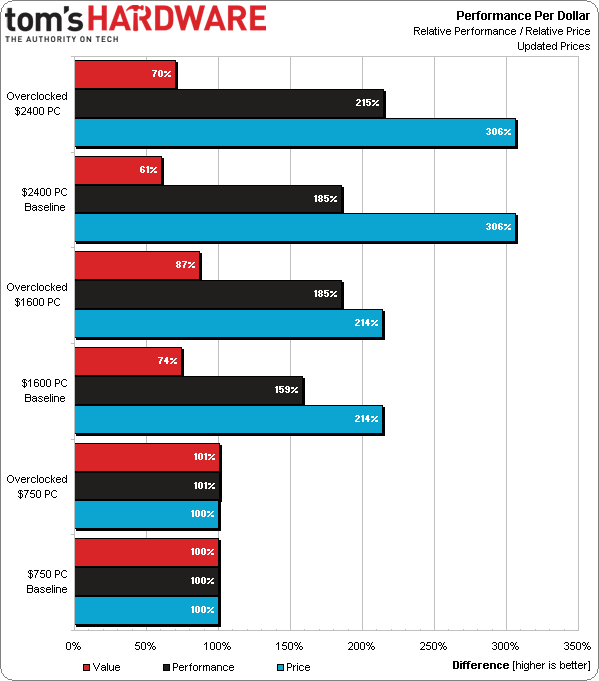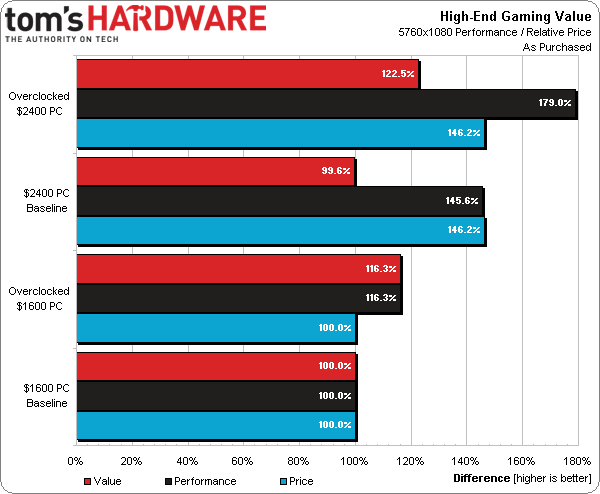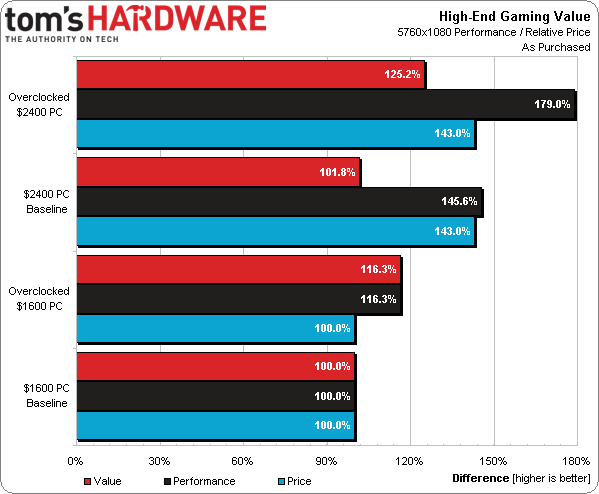System Builder Marathon Q1 2014: System Value Compared
Picking A Performance-Value Winner
A quick look at price-to-performance using purchase prices might not help you much today (since our parts were bought more than a month ago), but it can at least validate or negate each of our decisions. We do, after all, see a lot of Monday morning quarterbacking after new prices emerge.
The $750 machine yields the most bang for the buck, as expected, and the $1600 machine serves up $0.72 worth of extra performance for every dollar spent. The $2400 machine provides 58 cents of performance for every dollar spent beyond the $750 baseline, but over 80 cents in performance for every dollar spent over the $1600 PC (58%/72%, above). In other words, waste is a smaller percent of my $2400 machine's budget when I use the $1600 PC as a starting point.
Value improves slightly for the $1600 and $2400 machines after a couple months of price changes, but neither configuration will ever catch the $750 platform's high value. It would be better for enthusiasts who want a high-end machine to instead discuss their minimum performance standards.
Speaking of raising the bar on standards, gamers are the most vocal critics of our builds, and the $750 machine just isn’t quite capable of playing through our most taxing detail settings at 5760x1080. We know that because it failed a couple of tests at 4800x900.
Starting at 99.6% of the $1600 machine’s high-end gaming value, the $2400 PC appears nearly on-par with its rival...until I started overclocking it. More than $80 extra was spent to make it a better overclocker, and that expense is returned with a victory comparing my overclocking successes to Don's.
Recent price changes are even more forgiving to my $2400 effort, as it starts life with a 1.8% gaming-value lead that climbs to 7.7% (125.2%/116.3%, above) when both machines are overclocked.
Still, none of us can agree on which of these to buy. Aside from the $750 machine’s general value victory, the rest of our charts are just numbers, at the end of the day. That’s because each of us uses different games, applications, and monitor configurations in our own systems. That’s why I recommend looking at each individual benchmark result before picking a solution that best matches your needs.
Get Tom's Hardware's best news and in-depth reviews, straight to your inbox.
Congratulations to Paul for his continuous string of System Builder Marathon victories, and thanks to all readers for the feedback that helped shape this quarter’s competition.
Current page: Picking A Performance-Value Winner
Prev Page Overall Performance And Efficiency-
neiroatopelcc You really should add noise measurements on those builds. I'd much rather have a low noise system with mediocre performance than a fast but loud system. For that reason I returned my 7990 card in december and decided to stick with my trusty old 6950 that wasn't causing tinitusReply -
redgarl Value is such a contradicting analysis. If your goal is to be 4k ready, the the two cheapest build are not going to make the cut. It's all depending on your needs.Also, for any single graphic card, I would cut on the CPU. There is no need to link a 4770k with a single 780 GTX.Reply -
vertexx Nice work with the targeted High End Gaming value analysis! I'd 2nd switching it up so that Paul doesn't always win....Reply
A couple of thoughts:
1. Is it true that gaming only gets 20-30% of the overall performance weighting? If so, I'd suggest moving that up to at least 50%. Even though I'm one for a balanced system, I still think the amount of $$ you're spending on the graphics capability should be reflected more in the overall performance rating.
2. There is quite a bit of back-and-forth on the impact of power consumption on these forums, and I think this competition would be a great place to factor in and raise awareness on the real costs of power consumption. I understand that electricity costs and system use varies greatly. But I would add in another value analysis incorporating the present value of 3 years' electricity costs using a discount rate (simple excel function 'pv'). Of course you would have to make some broad assumptions around average power, hours of use per day, whether or not you idle the system 24x7, and electricity cost, but I think the present value of 3 year electricity cost would make a decent impact on your value calculations across these systems. -
neiroatopelcc Reply12974969 said:Of course you would have to make some broad assumptions around average power, hours of use per day, whether or not you idle the system 24x7, and electricity cost, but I think the present value of 3 year electricity cost would make a decent impact on your value calculations across these systems.
I would suggest making a forum poll regarding this. From my steam library I can tell that I've been playing games on average 2.25 hours a day over the last 5 years, and since the bulk of my games are on steam (1400+) it's not much below my real usage. However despite being a gamer I find myself having the computer either idle or playing youtube etc for an amount equal to the time I'm playing games. Assuming I'm around average, with regards to gaming:idling ratio, that'd mean perhaps 3 hours gaming and 3 hours idle/video playback a day on average. -
geoffrey4283 I'm not sure if this is what Gin Fushicho is referring to, but SurveyGizmo has been subject to a DDoS attack for the last ~24 hours, making your contest survey inaccessible.Reply -
winwiz Yes to me and most people I know, cost for power and noise is more important than 199 FPS in BF4Reply -
geofelt A typo:Your $750 build used a i3-4130, not the i7-4770K listed in the tested configurationsReply -
de5_Roy the links at the top of the page aren't enabled. the 4th link for value comparison is disabled on all 3 of the sbm pages.Reply
i didn't agree with any of the motherboard choices in this quarter's build. despite that, all three builds were very interesting in terms of performance, choice of parts and builds.
my takeaway from this is that ddr3 1333 is not the baseline for cheap system memory anymore. 2x 4GB ddr3 1600 and higher, especially 2x 8GB ddr3 1866 or higher memory is optimum for performance. don not enabling xmp for the $1600 pc's stock performance analysis helped me understand this.
haswell i7 ramped power and heat really high after 4.4ghz and bit more voltage. both were higher than don's previous o.c. of i5 4670k with asus z87-a board. i still don't like asrock. can you guys compare o.c. clockrates, temperature and voltage of haswell cpus used in sbm in q4 to see which combo was better? imo it'd help with how haswell behaves in real pcs instead of open test benches or test pcs.





